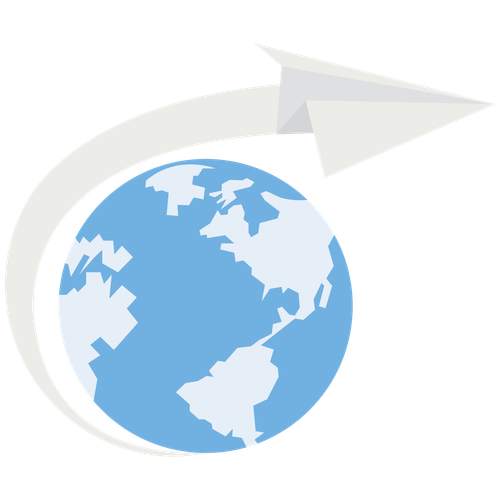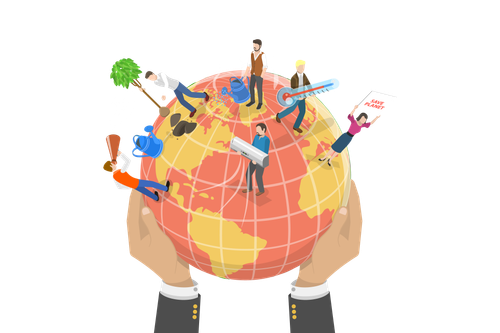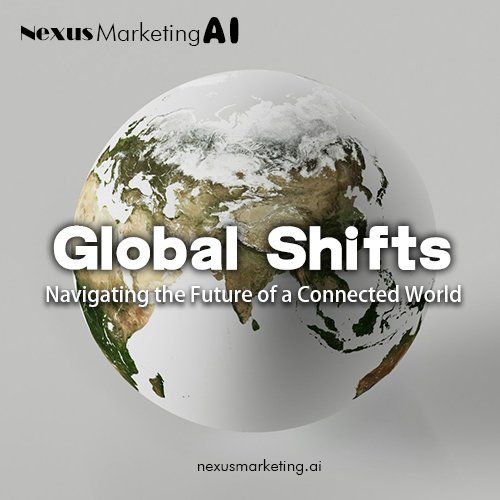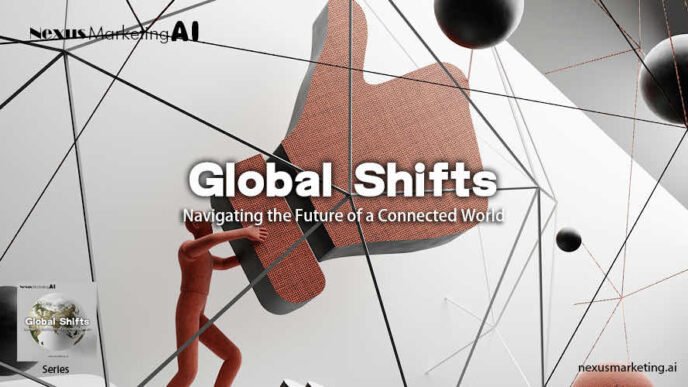Explore the future of globalization with key trends and predictions, understanding the forces shaping the next era of global interconnectedness.
Global Shifts
Navigating the Future of a Connected World
As the world becomes more interconnected, the forces driving globalization have far-reaching impacts on economies, businesses, and societies. This series dives deep into the core elements shaping today’s global landscape, from technological innovation and economic integration to cultural exchange and environmental sustainability.
Through a comprehensive exploration of these topics, “Global Shifts” offers thought-provoking insights into how businesses can adapt to this rapidly changing environment. Whether you’re a leader aiming to stay ahead of global trends or a professional seeking to understand the shifting dynamics of global trade, this series provides the essential knowledge to navigate the future of globalization.
Series
- Episode1.Globalization 101: Understanding the Basics
- Episode2.Economic Globalization: Trade and Investment Flows
- Episode3.Technological Globalization: The Role of Digitalization
- Episode4.Cultural Globalization: Cross-cultural Exchange and Influence
- Episode5.Political Globalization: Global Governance and Multilateralism
- Episode6.Sustainability in Globalization: Environmental Impact and Solutions
- Episode7.Global Supply Chains: Challenges and Opportunities
- Episode8.The Future of Globalization: Trends and Predictions
- Episode9.Challenges of Globalization: Inequality and Social Impacts
- Episode10.Globalization and Innovation: How Companies Stay Competitive
Table of Contents

Prefer to listen? Enjoy the audio version of this article
Curated audio version | Audio powered by AI
Introduction: The Evolving Nature of Globalization

Globalization has been a driving force behind economic growth, technological advancement, and cultural exchange over the past few decades. However, as the world continues to change, so too does the nature of globalization. From shifting economic power to technological innovations and environmental challenges, globalization is evolving in ways that will shape the future of trade, international relations, and global governance.

Overview of Globalization’s Current State
Globalization today is characterized by unprecedented levels of interconnectedness. International trade, cross-border investments, and the movement of people and ideas have created a deeply integrated global economy. Technology, particularly the internet, has accelerated these connections, making it easier for businesses to operate globally and for consumers to access products and services from all corners of the world.
However, globalization has also faced significant challenges in recent years. Geopolitical tensions, trade wars, and the COVID-19 pandemic have disrupted global supply chains and led to a reevaluation of global dependencies. While the benefits of globalization remain clear, the risks and vulnerabilities it exposes are prompting businesses, governments, and institutions to rethink their strategies for participating in the global economy.

The Forces Shaping the Future of Globalization
Several key forces are shaping the future of globalization. Technological advancements, such as artificial intelligence (AI), blockchain, and automation, are transforming industries and redefining how goods and services are produced and delivered. Meanwhile, shifting economic power, particularly the rise of emerging markets like China, India, and Southeast Asia, is changing the balance of global trade and investment.
Environmental sustainability is also becoming a central concern for the future of globalization. Climate change, resource depletion, and increasing pressure for sustainable practices are prompting businesses and governments to rethink how they approach global trade. At the same time, geopolitical shifts, including growing tensions between major economies and the rise of nationalism in some regions, are challenging the multilateral institutions that have traditionally supported globalization.
The future of globalization will likely be shaped by a combination of these factors, with both opportunities and challenges for businesses, governments, and consumers. As the global landscape continues to evolve, adaptability and resilience will be essential for navigating this new era of globalization.
Technological Advancements and the Digitalization of Global Trade

Technological innovations are driving significant changes in the way global trade is conducted. From automation to artificial intelligence, digital platforms, and blockchain, these technologies are reshaping supply chains, increasing efficiency, and enabling greater transparency across industries. As technology continues to advance, it will play an even more pivotal role in the future of globalization, transforming how businesses operate and interact across borders.

The Role of Artificial Intelligence and Automation
Artificial intelligence (AI) and automation are revolutionizing global industries, enhancing productivity, and reducing costs in ways that were previously unimaginable. In manufacturing, for instance, automation has enabled companies to produce goods at faster rates with fewer errors, minimizing labor costs and reducing reliance on human workers for repetitive tasks. Automated factories and robotics are already a reality in industries like automotive, electronics, and consumer goods, where global supply chains depend on high efficiency.
AI also plays a crucial role in optimizing global supply chains by predicting demand, managing inventory, and improving logistics operations. Through machine learning algorithms, companies can analyze massive datasets to identify patterns, forecast disruptions, and make more informed decisions. This predictive capability allows businesses to respond more quickly to changes in market conditions, such as fluctuating demand or shipping delays, helping to reduce inefficiencies and improve overall competitiveness.
However, the rise of AI and automation also poses challenges, particularly in terms of labor displacement. As machines take on more tasks traditionally performed by humans, the global workforce will need to adapt. Jobs that require repetitive, manual labor may become obsolete, while demand for highly skilled workers who can manage, develop, and operate AI systems will increase. This shift will require significant investment in education and training to ensure workers have the skills needed to thrive in a more automated global economy.

Blockchain and Supply Chain Transparency
Blockchain technology, originally developed for cryptocurrency, is transforming global supply chains by increasing transparency, security, and traceability. A blockchain is a decentralized, digital ledger that records transactions across a network of computers in a way that ensures the data is secure and tamper-proof. In the context of global trade, blockchain can be used to track the movement of goods from raw materials to final products, providing real-time visibility and accountability across the entire supply chain.
One of the most significant benefits of blockchain in global trade is its ability to reduce fraud and counterfeiting. By providing a secure and transparent record of every transaction, blockchain makes it more difficult for bad actors to manipulate data or introduce counterfeit goods into the supply chain. This is especially valuable in industries such as pharmaceuticals, luxury goods, and food, where ensuring the authenticity and safety of products is critical.
Additionally, blockchain can streamline the documentation process in international trade, reducing the need for intermediaries and minimizing paperwork. This can lead to faster transactions, lower costs, and fewer delays in shipping and customs processes. As more businesses adopt blockchain, it has the potential to revolutionize how global trade is conducted, making it more efficient, secure, and transparent.

The Growth of Digital Platforms and E-commerce
The rise of digital platforms and e-commerce has fundamentally changed how businesses operate globally. Platforms like Amazon, Alibaba, and Shopify have enabled businesses of all sizes to reach international markets, bypassing traditional distribution networks and connecting directly with consumers. This shift has democratized global trade, allowing small and medium-sized enterprises (SMEs) to compete on a global scale without the need for extensive physical infrastructure.
E-commerce has also transformed consumer behavior, with shoppers expecting faster delivery times, greater product variety, and more personalized experiences. To meet these demands, companies are investing in advanced logistics networks, automated fulfillment centers, and real-time inventory management systems. The growth of e-commerce has also led to the expansion of digital payment systems, which make cross-border transactions more seamless and accessible.
As digital platforms continue to grow, the line between traditional commerce and e-commerce will blur, with more businesses adopting hybrid models that combine online and offline channels. The integration of digital tools into global trade will enable businesses to scale more efficiently, adapt to changing consumer expectations, and respond quickly to market shifts. However, this growth will also require businesses to navigate challenges such as cybersecurity threats, data privacy concerns, and the regulatory complexities of operating in multiple markets.
Shifting Economic Power and the Rise of Emerging Markets

Global economic power is shifting, with emerging markets becoming increasingly influential players in the global economy. As countries in Asia, Africa, and Latin America continue to grow rapidly, they are reshaping global trade dynamics, investment flows, and innovation landscapes. This shift presents both opportunities and challenges for businesses and policymakers as the global economic center of gravity moves away from traditional powerhouses like the United States and Europe.

The Economic Rise of Asia
Asia, particularly China and India, has emerged as a major driver of global economic growth. China, with its vast manufacturing capabilities, technological advancements, and large consumer base, has become the world’s second-largest economy and a critical player in global supply chains. China’s Belt and Road Initiative (BRI), which aims to build infrastructure and boost trade across Asia, Europe, and Africa, is a testament to the country’s ambition to further integrate with the global economy and expand its influence.
India, on the other hand, is becoming a global hub for technology, innovation, and services. With its young and rapidly growing population, India is poised to become one of the largest consumer markets in the world. The country’s thriving IT sector, supported by its skilled workforce, is attracting investments from global tech giants, making India a key player in the digital economy. As India continues to develop its infrastructure and regulatory environment, its role in global trade and investment will only grow stronger.
Southeast Asia is another region experiencing rapid economic growth. Countries like Vietnam, Indonesia, and the Philippines have become attractive destinations for manufacturing and investment as businesses look to diversify away from China. The ASEAN (Association of Southeast Asian Nations) region, with its growing middle class and favorable demographics, is increasingly becoming a key player in global supply chains and a hub for innovation in industries like electronics, apparel, and digital services.

The Role of Africa in the Global Economy
Africa is emerging as the next frontier for global economic growth. With a population of over 1.2 billion and a growing middle class, the continent is becoming an attractive market for businesses and investors. Africa is rich in natural resources, including minerals, oil, and agricultural products, which are essential to global supply chains. Additionally, Africa’s youthful population presents significant opportunities for labor-intensive industries and consumer markets.
The African Continental Free Trade Area (AfCFTA), launched in 2021, is expected to be a game changer for the continent’s integration into the global economy. By creating the world’s largest free trade area, AfCFTA aims to reduce tariffs, increase trade between African countries, and attract foreign investment. This agreement has the potential to boost economic growth, create jobs, and enhance Africa’s competitiveness in global markets.
However, Africa still faces significant challenges, including infrastructure deficits, political instability, and a lack of skilled labor in some regions. Addressing these challenges will be crucial for realizing the continent’s full potential in the global economy. As African nations continue to improve governance and invest in education, technology, and infrastructure, they are likely to become increasingly important players in global trade and investment.

Latin America’s Integration into Global Markets
Latin America is also gaining prominence in the global economy, with countries like Brazil, Mexico, and Chile playing key roles in sectors such as agriculture, energy, and mining. The region’s abundant natural resources make it a critical supplier of commodities like soybeans, copper, and oil, which are essential to industries around the world.
In addition to its resource wealth, Latin America is seeing growing interest in its technology and innovation sectors. Countries like Mexico and Brazil have vibrant startup ecosystems, and there is a growing push toward digitalization and innovation in industries such as fintech, e-commerce, and renewable energy. Latin America’s strategic location, especially with proximity to North American markets, makes it an attractive partner for trade and investment.
However, Latin America faces challenges in terms of political instability, economic inequality, and regulatory hurdles. Many countries in the region are working to strengthen governance, attract foreign direct investment, and diversify their economies away from dependence on commodities. As these reforms take hold, Latin America’s role in the global economy is likely to expand, offering new opportunities for businesses and investors.
Globalization and Environmental Sustainability

As globalization continues to evolve, environmental sustainability is becoming an increasingly critical issue. The future of global trade, production, and consumption will be shaped by how countries and businesses address the environmental challenges posed by climate change, resource depletion, and pollution. Balancing economic growth with environmental responsibility will be a central theme of globalization in the coming decades.

Decarbonization of Global Industries
One of the most pressing environmental challenges is the need to decarbonize global industries. Sectors such as energy, manufacturing, transportation, and agriculture are major contributors to greenhouse gas emissions, which are driving climate change. Decarbonization involves reducing carbon emissions by transitioning to renewable energy sources, improving energy efficiency, and adopting cleaner technologies across industries.
Renewable energy sources like wind, solar, and hydropower are becoming more accessible and cost-effective, enabling businesses and governments to reduce their reliance on fossil fuels. The global push for net-zero carbon emissions by mid-century is accelerating this transition, with countries and companies setting ambitious targets for reducing their carbon footprints. For example, the European Union’s Green Deal aims to make Europe the first climate-neutral continent by 2050, while companies like Apple, Google, and Unilever have pledged to achieve carbon neutrality in their operations.
Decarbonizing global industries also requires investment in technologies such as carbon capture and storage (CCS) and the electrification of transportation and manufacturing. Innovations like hydrogen fuel cells and advanced battery storage systems are also expected to play key roles in reducing emissions. As global industries move toward decarbonization, the demand for sustainable solutions and green technologies will continue to grow, creating new opportunities for businesses that can deliver environmentally responsible products and services.

International Collaboration on Climate Action
Global environmental challenges, such as climate change and biodiversity loss, require international cooperation. Multilateral agreements like the Paris Agreement have brought countries together to set targets for reducing emissions and mitigating the impacts of climate change. However, achieving these targets will require sustained commitment and collaboration among nations.
The Paris Agreement, signed in 2015, is a landmark global accord in which nearly every country pledged to limit global temperature rise to well below 2 degrees Celsius, with efforts to limit the increase to 1.5 degrees. Countries submit Nationally Determined Contributions (NDCs), outlining their plans to reduce greenhouse gas emissions and adapt to the impacts of climate change. While the Paris Agreement provides a framework for global action, the success of these efforts depends on the political will of individual nations and their ability to implement effective policies.
In addition to the Paris Agreement, other multilateral efforts are helping to address specific environmental issues. The United Nations’ Sustainable Development Goals (SDGs), for example, provide a comprehensive framework for achieving sustainability in areas such as clean energy, sustainable cities, and responsible consumption. As environmental issues become more urgent, international collaboration will be key to aligning global efforts and ensuring that the benefits of globalization do not come at the expense of the planet.

Sustainable Trade Practices and Green Supply Chains
As consumers and businesses become more environmentally conscious, there is growing demand for sustainable trade practices and green supply chains. Companies are under increasing pressure to reduce their environmental impact, not only to comply with regulations but also to meet the expectations of eco-conscious consumers and investors.
Sustainable trade practices include minimizing the environmental footprint of transportation, reducing waste in production processes, and sourcing materials from sustainable and ethical suppliers. Companies like Patagonia and IKEA are leading the way in promoting sustainable business models, focusing on reducing emissions, using recycled materials, and adopting circular economy principles.
Green supply chains involve redesigning logistics and manufacturing processes to reduce carbon emissions, improve energy efficiency, and ensure sustainable resource use. Many companies are investing in renewable energy for their production facilities, optimizing transportation routes to minimize fuel consumption, and using digital tools to track the environmental impact of their supply chains. By adopting green supply chain practices, businesses can not only reduce their environmental footprint but also gain a competitive advantage in a marketplace that increasingly values sustainability.
Geopolitical Shifts and the Future of Global Governance

The global political landscape is rapidly changing, with major geopolitical shifts influencing the direction of globalization. As economic power realigns and new political dynamics emerge, the future of global governance and multilateral cooperation will play a crucial role in shaping global trade, diplomacy, and security. Understanding these changes is essential for navigating the evolving landscape of globalization.

The Impact of U.S.-China Relations on Globalization
The relationship between the United States and China is one of the most significant geopolitical factors shaping the future of globalization. As the world’s two largest economies, the U.S. and China play key roles in global trade, technology, and finance. However, tensions between the two countries—manifested in trade wars, technological competition, and ideological differences—have the potential to disrupt global supply chains, investment flows, and multilateral cooperation.
The U.S.-China trade war, which began in 2018, resulted in billions of dollars in tariffs on goods and heightened uncertainty for businesses that rely on global supply chains. Companies have responded by diversifying their suppliers and reducing their dependence on Chinese manufacturing. This decoupling of U.S.-China trade has raised questions about the future of global trade integration and the potential for a more fragmented global economy.
In addition to trade, the two countries are competing for dominance in emerging technologies, such as 5G, artificial intelligence, and quantum computing. The U.S. has imposed restrictions on Chinese tech companies like Huawei, citing national security concerns, while China continues to push for self-sufficiency in key technologies. The technological competition between the U.S. and China will have far-reaching implications for the future of innovation, intellectual property, and digital governance.
Despite these challenges, the U.S. and China remain deeply intertwined, and their relationship will continue to shape the future of globalization. The two countries must find ways to navigate their differences while cooperating on critical global issues like climate change, public health, and cybersecurity.

Regional Trade Agreements and Multilateralism
While geopolitical tensions between major powers may challenge multilateralism, regional trade agreements are becoming increasingly important for maintaining and enhancing global trade. These agreements facilitate economic cooperation between neighboring countries, often bypassing the complexities of broader multilateral negotiations. Regional trade agreements such as the United States-Mexico-Canada Agreement (USMCA) and the Regional Comprehensive Economic Partnership (RCEP) in Asia are examples of how regions are consolidating their economic ties.
RCEP, the largest regional trade agreement in history, includes 15 Asia-Pacific nations and accounts for nearly one-third of the world’s population and global GDP. It aims to reduce tariffs, simplify customs procedures, and promote investment between member countries, enhancing the region’s integration into global supply chains. Meanwhile, USMCA strengthens trade relations between the U.S., Mexico, and Canada, ensuring continued cooperation in North America’s highly integrated automotive, agriculture, and manufacturing sectors.
These regional agreements reflect a growing trend towards regionalism in global trade, as countries seek to strengthen their economic ties with neighboring markets. While regional agreements can help mitigate the risks of global trade disruptions, they also underscore the need for broader multilateral cooperation to address global challenges like climate change, cybersecurity, and financial stability.

The Role of Global Organizations in the Future of Governance
Global organizations such as the United Nations (UN), the World Trade Organization (WTO), and the International Monetary Fund (IMF) have long played pivotal roles in shaping global governance. However, as the geopolitical landscape shifts and new challenges emerge, these institutions are facing increasing pressure to reform and adapt.
The WTO, for example, has struggled to address modern trade issues, such as digital trade and intellectual property, while managing disputes between major economies. Calls for reform have grown, with some countries pushing for more transparent decision-making processes and greater enforcement mechanisms. Similarly, the UN faces challenges in maintaining peace and security in an increasingly polarized world, particularly in addressing issues like climate change, humanitarian crises, and global health threats.
As global challenges become more complex, the role of international organizations will be critical in promoting cooperation, resolving conflicts, and ensuring that globalization remains a force for positive change. Reforms that enhance the effectiveness and legitimacy of these institutions will be essential for fostering global stability and addressing the interconnected challenges of the 21st century.
The Human Aspect of Globalization’s Future

While much of the discussion around the future of globalization focuses on economic trends and technological advancements, it is equally important to consider the human element. Globalization has far-reaching impacts on labor markets, education, and culture. As technology transforms industries and international connections deepen, societies must adapt to these changes, ensuring that the benefits of globalization are distributed equitably and that human rights and well-being are prioritized.

The Future of Work in a Globalized Economy
The rise of automation, artificial intelligence, and digital platforms is fundamentally changing the nature of work. In the future, many traditional jobs, particularly those involving repetitive tasks, will be replaced by machines or algorithms. This shift presents both opportunities and challenges for the global workforce.
On the one hand, automation can lead to greater efficiency, productivity, and innovation. Jobs in industries such as manufacturing, logistics, and customer service may decline, but new opportunities will emerge in fields like technology, data analysis, and creative industries. The gig economy, fueled by digital platforms like Uber, Fiverr, and Upwork, is already reshaping how people work, offering more flexible and remote opportunities.
However, the automation revolution also risks exacerbating income inequality, as lower-skilled workers are more likely to be displaced by technology. Governments, businesses, and educational institutions will need to focus on reskilling and upskilling workers to ensure they can thrive in a rapidly evolving job market. Lifelong learning and the development of digital literacy will be key components of preparing the global workforce for the future of work in a more globalized and automated economy.

Education and Skills Development for a Globalized World
As the future of work changes, so too must the approach to education and skills development. The interconnected nature of the global economy requires a workforce that is not only technically proficient but also culturally aware and adaptable. Globalization places a premium on skills such as communication, critical thinking, problem-solving, and collaboration—traits that are essential for navigating complex, cross-cultural environments.
To prepare future generations for the demands of a globalized world, education systems must adapt by incorporating digital skills, cross-cultural understanding, and a global perspective into curricula. Vocational training and apprenticeships in emerging industries such as renewable energy, AI, and healthcare will become increasingly important, while higher education institutions will need to provide more opportunities for international exchange and collaborative research.
Additionally, digital learning platforms and online education will play a key role in democratizing access to education globally. These platforms allow individuals from developing countries or remote regions to access high-quality educational content, helping to close the global skills gap. Governments and private sector actors must collaborate to ensure that education remains a driving force in fostering inclusive and sustainable globalization.

The Cultural Exchange and Influence of Globalization
Globalization has brought about an unprecedented level of cultural exchange. People around the world are more connected than ever before, sharing ideas, art, food, music, and values across borders. The internet and social media have accelerated this cultural diffusion, allowing individuals to experience diverse cultures without leaving their homes.
While cultural globalization fosters mutual understanding and promotes diversity, it also raises concerns about cultural homogenization, where dominant cultures overshadow local traditions and identities. The global dominance of Western media and consumer culture, for instance, has led to fears that smaller, less dominant cultures may be eroded over time.
To maintain a balance between preserving cultural heritage and embracing global diversity, countries must support policies that promote the protection of local languages, traditions, and arts. Cultural exchange should be based on mutual respect and appreciation, allowing societies to benefit from globalization without losing their unique identities. By promoting inclusive cultural policies and fostering dialogue, nations can ensure that globalization enhances rather than diminishes cultural diversity.
Navigating the Future of Globalization

The future of globalization will be shaped by a complex interplay of technological advancements, shifting economic power, environmental sustainability, and geopolitical dynamics. As globalization evolves, it is clear that its benefits and challenges will be felt across industries, societies, and borders. Successfully navigating this new era will require adaptability, innovation, and a commitment to inclusive and sustainable growth.

Balancing Globalization with Localization
As businesses and governments rethink their strategies for participating in the global economy, balancing globalization with localization will be key. While global interconnectedness brings economic opportunities, it also exposes vulnerabilities in supply chains and local markets. A hybrid approach—where companies maintain global ties but also invest in local production, supply chains, and workforce development—can create resilience in an increasingly uncertain world. This localized approach can also help mitigate the negative impacts of globalization on local cultures and economies.

Adapting to an Uncertain Future
The future of globalization is uncertain, with both opportunities and risks ahead. Technological innovation, while transformative, poses significant disruptions to labor markets. Shifts in geopolitical power and the rise of emerging markets will challenge the traditional dominance of Western economies. Climate change and the demand for sustainability will reshape how industries operate and countries collaborate. To thrive in this environment, businesses, policymakers, and individuals must remain adaptable and forward-thinking, ready to respond to rapid changes in the global landscape.

Link to Next Episode: Challenges of Globalization
The next episode, “Challenges of Globalization: Inequality and Social Impacts,” will explore the darker side of globalization. It will delve into the growing concerns about income inequality, labor exploitation, and the social consequences of economic integration. This episode will focus on how globalization has widened the gap between the rich and the poor, and what can be done to ensure that globalization benefits all members of society, not just the privileged few.
FAQs
-
What are the key trends shaping the future of globalization?
The future of globalization is being shaped by several key trends, including technological advancements, regional trade agreements, the rise of digital and green economies, and shifts in global power dynamics. These trends are redefining how countries interact, trade, and collaborate on global issues, influencing the pace and nature of globalization.
-
How will technology influence the next phase of globalization?
Technology will continue to be a driving force in globalization, enhancing connectivity, automation, and innovation. Technologies such as artificial intelligence, blockchain, and the Internet of Things (IoT) are expected to transform industries, streamline global supply chains, and create new opportunities for digital trade. However, technology also presents challenges, such as cybersecurity risks and the need for digital inclusion.
-
What role will regionalism play in the future of globalization?
Regionalism is becoming increasingly prominent as countries form regional trade agreements like the European Union (EU) and the Regional Comprehensive Economic Partnership (RCEP). These agreements promote closer economic ties within regions and may shape the future of globalization by encouraging regional self-reliance, reducing dependency on distant markets, and providing a buffer against global disruptions.
-
How is the shift towards a green economy impacting globalization?
The shift towards a green economy is reshaping globalization by prioritizing sustainable trade practices, renewable energy, and environmentally friendly technologies. As countries adopt stricter environmental standards, businesses are increasingly focusing on reducing their carbon footprint and implementing circular economy models. This green transition is driving global cooperation on climate change but also presents challenges for industries reliant on traditional, high-emission practices.
-
What is the impact of digital trade on globalization?
Digital trade is transforming globalization by enabling the seamless exchange of goods, services, and information across borders. E-commerce platforms, digital payment systems, and virtual marketplaces are breaking down barriers to entry, allowing businesses of all sizes to access global markets. However, digital trade also raises issues related to data privacy, cybersecurity, and digital infrastructure disparities.
-
How are geopolitical tensions affecting the future of globalization?
Geopolitical tensions, such as U.S.-China trade disputes, Brexit, and regional conflicts, are creating uncertainties in the global economy. These tensions can lead to trade restrictions, tariffs, and supply chain disruptions, potentially slowing down the pace of globalization. As countries navigate these challenges, there may be a shift towards more localized or regionally focused economic strategies.
-
What role will emerging markets play in the future of globalization?
Emerging markets, particularly in Asia, Africa, and Latin America, are expected to play a significant role in the future of globalization. These regions are experiencing rapid economic growth, urbanization, and technological adoption, making them key drivers of global demand. As emerging markets gain influence, they will shape global trade patterns, investment flows, and innovation.
-
How is globalization evolving in response to the COVID-19 pandemic?
The COVID-19 pandemic has accelerated certain aspects of globalization, such as digital transformation and remote work, while highlighting vulnerabilities in global supply chains. In response, businesses and governments are reevaluating their approaches to resilience, supply chain diversification, and international cooperation. The pandemic has underscored the need for more adaptive and flexible globalization strategies.
-
What is the impact of automation on the global workforce?
Automation is reshaping the global workforce by replacing routine tasks with machines and AI-driven processes. While automation increases efficiency and lowers costs, it also raises concerns about job displacement and the need for reskilling. The future of globalization will likely see a greater emphasis on digital skills and new job opportunities in tech-driven sectors.
-
How will global governance evolve in the future of globalization?
Global governance will need to adapt to the complexities of a rapidly changing world, addressing issues like digital regulation, climate change, and international trade disputes. Organizations such as the United Nations, World Trade Organization, and G20 will play pivotal roles in facilitating cooperation and setting global standards. Strengthening multilateralism and inclusive decision-making will be critical for managing the challenges and opportunities of future globalization.














